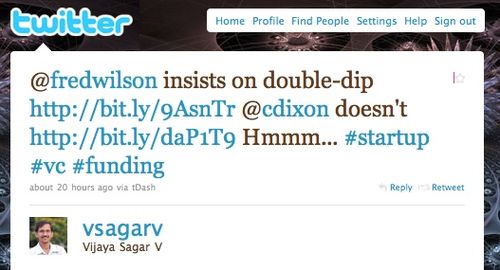An Evolved View Of The Participating Preferred
One of the issues with a trail of 5,000 blog posts going back over seven years is that sometimes you change your mind on something you wrote a long time ago but the words are still out there. That's the case with the issue of the participating preferred.
Yesterday, I came upon this tweet by Vijaya Sagar Vinnakota:
So I clicked thru to the first link and found a post I had written about participating preferred in 2004. In that post I stated "I insist on participating preferreds and get them in almost all of my deals."
Now some of you are wondering what a participating preferred is. I'll give you a brief explanation and then send you off to Brad Feld's blog for a complete description.
In a preferred stock, the investor gets the option of taking their money back in a sale or taking the share of the company they bought. I believe a preferred stock is critical in venture investing. However a participating preferred goes one step further. In a participating preferred, the investor gets their money back and then gets their ownership share of what is left.
Let's do a simple example. Let's say you invest $1mm for 10% of the business. And let's say the business is sold for $25mm. In a preferred (sometimes called a "straight preferred") you get the choice of getting your $1mm back or 10% of $25mm. You'll take the $2.5mm.
But if you own a participating preferred, you get your $1mm back and then you split the $24mm that is left with the founder. So you get $2.4mm of what is left and the founder gets $21.6mm. You end up getting $3.4mm with the participating preferred vs $2.5mm in the straight preferred.
I grew up in the venture capital business in a firm that had the participating feature in its standard term sheet. I believed it was fair, particularly when there was a cap on "double dip" and that is what I believed in 2004 and wrote in the post I linked to above.
My views on this issue have evolved since then. The participating preferred is not in our standard early stage term sheet. It is not in any of our seed investments. We don't have it in "all of our deals."
However, we do still use the participating preferred in two circumstances. First, it is a great way to bridge a valuation gap with an entrepreneur. Let's say we feel the business is worth $10mm but the entrepreneur feels it is worth $20mm. We could bridge that valuation gap by agreeing to pay $20mm with a participating preferred. If the Company is a big winner, then it won't matter if we paid $10mm or $20mm. But if the Company is sold for a smaller number, say $50mm, then having the participating feature gives us a return that is closer to what it would have been at our target valuation of $10mm.
The other place a participating feature is useful is when the entrepreneur might want to sell the company relatively soon after your investment. In that case, there is a risk that not much value will be created between your investment and an exit. A participating preferred works well in that situation as well.
In both cases where we still use the participating preferred, we cap it at a multiple of our investment, usually 3x. I mentioned that in my post back in 2004 and I have always believed that a participating preferred needs to come with a cap.
So that's my evolved view of this provision. I believe the venture business has changed as the capital required to create significant value in web services companies has fallen dramatically. That capital efficiency brings new economics to venture investing and terms need to evolve to reflect that.



![Reblog this post [with Zemanta]](http://img.zemanta.com/reblog_e.png?x-id=25efadb2-5dfe-4139-ab40-9f4471d77570)




